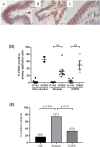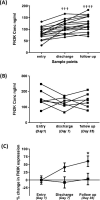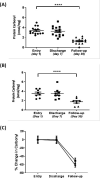FN3K expression in COPD: a potential comorbidity factor for cardiovascular disease
- PMID: 33208304
- PMCID: PMC7677354
- DOI: 10.1136/bmjresp-2020-000714
FN3K expression in COPD: a potential comorbidity factor for cardiovascular disease
Erratum in
-
Correction: FN3K expression in COPD: a potential comorbidity factor for cardiovascular disease.BMJ Open Respir Res. 2021 Jan;8(1):e000714corr1. doi: 10.1136/bmjresp-2020-000714corr1. BMJ Open Respir Res. 2021. PMID: 33462091 Free PMC article. No abstract available.
Abstract
Introduction: Cigarette smoking and oxidative stress are common risk factors for the multi-morbidities associated with chronic obstructive pulmonary disease (COPD). Elevated levels of advanced glycation endproducts (AGE) increase the risk of cardiovascular disease (CVD) comorbidity and mortality. The enzyme fructosamine-3-kinase (FN3K) reduces this risk by lowering AGE levels.
Methods: The distribution and expression of FN3K protein in lung tissues from stable COPD and control subjects, as well as an animal model of COPD, was assessed by immunohistochemistry. Serum FN3K protein and AGE levels were assessed by ELISA in patients with COPD exacerbations receiving metformin. Genetic variants within the FN3K and FN3K-RP genes were evaluated for associations with cardiorespiratory function in the Subpopulations and Intermediate Outcome Measures in COPD Study cohort.
Results: This pilot study demonstrates that FN3K expression in the blood and human lung epithelium is distributed at either high or low levels irrespective of disease status. The percentage of lung epithelial cells expressing FN3K was higher in control smokers with normal lung function, but this induction was not observed in COPD patients nor in a smoking model of COPD. The top five nominal FN3K polymorphisms with possible association to decreased cardiorespiratory function (p<0.008-0.02), all failed to reach the threshold (p<0.0028) to be considered highly significant following multi-comparison analysis. Metformin enhanced systemic levels of FN3K in COPD subjects independent of their high-expression or low-expression status.
Discussion: The data highlight that low and high FN3K expressors exist within our study cohort and metformin induces FN3K levels, highlighting a potential mechanism to reduce the risk of CVD comorbidity and mortality.
Keywords: COPD ÀÜ mechanisms; systemic disease and lungs.
© Author(s) (or their employer(s)) 2020. Re-use permitted under CC BY-NC. No commercial re-use. See rights and permissions. Published by BMJ.
Conflict of interest statement
Competing interests: None declared.
Figures





References
Publication types
MeSH terms
Substances
Grants and funding
- HHSN268200900019C/HL/NHLBI NIH HHS/United States
- 093080/Z/10/Z/WT_/Wellcome Trust/United Kingdom
- HHSN268200900015C/HL/NHLBI NIH HHS/United States
- HHSN268200900016C/HL/NHLBI NIH HHS/United States
- I01 CX000911/CX/CSRD VA/United States
- U01 HL137880/HL/NHLBI NIH HHS/United States
- R01 HL142992/HL/NHLBI NIH HHS/United States
- HHSN268200900018C/HL/NHLBI NIH HHS/United States
- HHSN268200900014C/HL/NHLBI NIH HHS/United States
- MR/T010371/1/MRC_/Medical Research Council/United Kingdom
- K08 HL118128/HL/NHLBI NIH HHS/United States
- HHSN268200900017C/HL/NHLBI NIH HHS/United States
- HHSN268200900020C/HL/NHLBI NIH HHS/United States
- HHSN268200900013C/HL/NHLBI NIH HHS/United States
- WT_/Wellcome Trust/United Kingdom
LinkOut - more resources
Full Text Sources
Medical
Molecular Biology Databases
